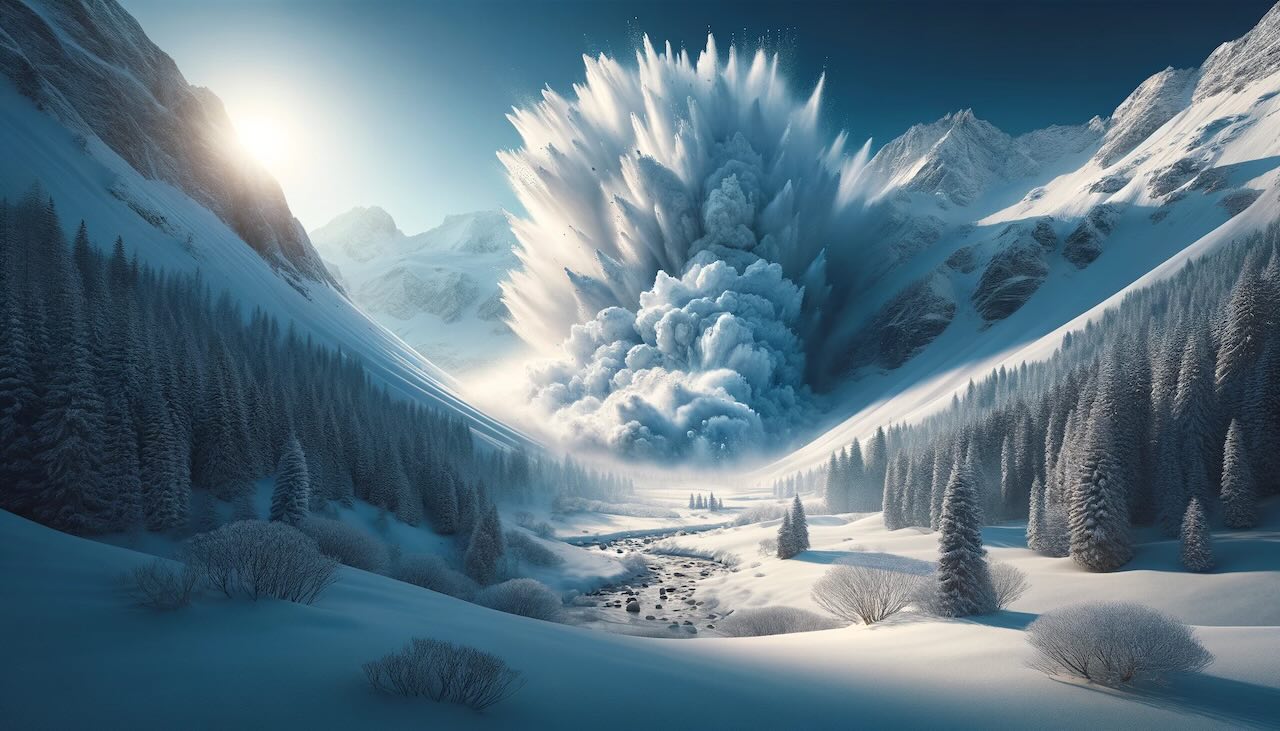Introduction
Avalanches are among the most terrifying natural disasters in mountainous regions, known for their suddenness and destructive power. The idea that a beautiful snowy landscape can turn into a life-threatening situation in an instant is a significant concern for anyone visiting snow-covered mountains.
In this article, we will discuss:
- The dangers of avalanches
- The causes of avalanches
- The leading causes of death in avalanches
- Essential knowledge and preventive measures to protect yourself from avalanches
Causes of Avalanches
Avalanches pose a serious threat to many people enjoying winter recreation in mountainous areas. However, understanding the causes behind this natural phenomenon can help reduce the risks. Exploring the main factors that trigger avalanches is essential for safely enjoying the mountains.
1. Snow Instability
The most common cause of avalanches is weak bonding between layers of snow. When newly fallen snow does not bond well with the older layer beneath, the weight of the upper layer can cause it to slide. This phenomenon is particularly likely when heavy, wet snow falls on top of light, dry snow.
2. Rapid Temperature Changes
Abrupt increases in temperature can destabilize the snow layers, potentially triggering an avalanche. Warm temperatures melt the snow, reducing friction between the layers and making the upper layer more likely to slide.
3. Strong Winds
Strong winds can transport snow from one side of a mountain to the other. This can stabilize the windward side while creating unstable accumulations of snow on the leeward side, increasing the risk of avalanches. Wind-loaded snow is particularly prone to instability.
4. Human Activities
Human activities such as skiing, snowboarding, and mountaineering can also trigger avalanches. Moving across an unsettled snow layer can cause the layer beneath to suddenly slide.
While avalanches are one of nature’s most unpredictable phenomena, understanding their causes and learning how to mitigate the risks can greatly enhance the safety of mountain activities. Respecting the power of nature and maintaining constant preparation and vigilance are key to safely enjoying time in the mountains.
Leading Causes of Death in Avalanches
Avalanche fatalities often result in grave consequences for those involved due to the sudden occurrence and overwhelming force of the event. Among the few survivors, there are several causes of death that avalanche victims face, each highlighting the terrifying nature of avalanches.
Asphyxiation
When caught in an avalanche, victims are often buried under the snow. The most common cause of death in this situation is asphyxiation. Being covered in snow limits oxygen availability, making breathing difficult. As time passes before rescue, oxygen gradually depletes, ultimately leading to death by suffocation.
Hypothermia
Prolonged exposure beneath the snow can cause a rapid decrease in body temperature, resulting in hypothermia. When the body temperature drops below the normal range, bodily functions gradually decline, potentially leading to unconsciousness and death. The risk increases if rescue is not swift.
Trauma
The immense force of an avalanche can propel victims into rocks, trees, or other obstacles, causing severe trauma or instant death. The impact force can be particularly significant in high-speed avalanches, potentially inflicting life-threatening injuries.
Understanding the leading causes of death in avalanches is crucial for recognizing the true dangers of this natural phenomenon and implementing appropriate preparedness and response strategies. While engaging in mountain activities always involves some risk, knowledge and preparation can help minimize that risk. Everyone enjoying the snowy mountains should maintain a high level of alertness and a constant awareness of avalanche safety.
Avalanche Fatality Rates
Avalanche fatality rates are influenced by many factors, but once an avalanche occurs and someone is caught in it, the survival rate drops dramatically. The size of the avalanche, the location, the environment the victim encounters, and the time until rescue are among the various elements that contribute to fatal outcomes.
One of the most critical factors is the time between being caught in an avalanche and being rescued. Statistics show that if a victim is found within the first 15 minutes, the survival rate is about 90%. However, if the time exceeds 30 minutes, the survival rate drops significantly to around 50%. After 45 minutes, the survival rate further decreases to below 20%. This is because asphyxiation is the primary cause of death in avalanches, making prompt rescue essential for survival.
Furthermore, the type of avalanche (slab, loose snow, etc.) and the characteristics of the slope where it occurs also greatly influence the extent of the damage. While slab avalanches are relatively small and often have higher survival rates, full-depth avalanches can bury victims deep under the snow, drastically reducing the chances of survival.
These statistics emphasize the importance of proper preparation and knowledge in avoiding the dangers of avalanches. To increase the chances of survival during an avalanche, it is essential to correctly assess the risks and take necessary safety precautions. Carrying avalanche safety gear such as beacons, probes, and shovels, and being well-versed in their use, can be life-saving in the event of an emergency.
Warning Signs of an Avalanche
While avalanches may seem to occur suddenly, there are usually several warning signs that precede them. Recognizing these signs can enhance safety in the mountains. The main indicators to watch for when assessing avalanche risk include:
1. Heavy Snowfall
If more than 20 cm of new snow has fallen within the last 48 hours, the likelihood of an avalanche increases. New snow often fails to stabilize on old snow layers, particularly on steep slopes, potentially causing it to slide.
2. Rising Temperatures
Rapid increases in temperature can alter the structure of the snow, increasing the risk of avalanches. When frozen snow begins to melt, friction between the snow layers decreases, making avalanches more likely.
3. Cracks in the Snow
If you hear a “whumping” sound underfoot or see cracks in the snow surface while walking or skiing, it’s a sign that the snow layers are unstable. These cracks indicate that an avalanche may be imminent.
4. Collapsing Snow Layers
When upper snow layers collapse under their own weight, pushing down on weaker layers beneath, it’s another sign of avalanche risk. This often suggests that the lower layer is weaker, and the upper layer may suddenly slide.
5. Evidence of Previous Avalanches
If there are signs of previous avalanches in the same area, it indicates a risk of recurrence. History can repeat itself, particularly under similar conditions.
To avoid missing these warning signs, it’s crucial to always check the latest avalanche forecasts before heading into the mountains and to act cautiously while there. Reading nature’s signs and prioritizing safety are key to protecting oneself from the dangers of avalanches.
Avalanche Safety: Preparation and Knowledge
Avalanches are predictable disasters, and with appropriate measures, risks can be reduced, and safety ensured. Here are the main strategies to prepare for avalanche risks and enhance safety in the mountains.
1. Education and Training
- Learn the basics of avalanches and safe behavior principles.
- Participate in avalanche rescue training to learn how to use beacons and search techniques with probes and shovels.
2. Carrying Appropriate Equipment
- Always carry avalanche beacons (transceivers), probes, and shovels, and be well-versed in their use.
- Consider additional safety equipment such as avalanche airbags and helmets when necessary.
3. Planning and Judgment
- Always check the latest weather forecasts and avalanche risk reports before heading out.
- When selecting routes, consider slope angles, snow conditions, and weather changes, and plan to avoid risks.
4. Communication and Cooperation Within Groups
- Whenever possible, travel in groups and maintain constant communication among members.
- Ensure that all group members carry safety equipment and share the responsibility for each other’s safety.
5. Attention to Natural Signs
- Pay attention to avalanche warning signs and weather changes, and be flexible in altering plans based on the situation.
6. Emergency Preparedness
- Confirm emergency contact information in advance and prepare for contingencies.
- Share your travel plans with family or friends and avoid deviating from the plan.
While these measures do not eliminate avalanche risks entirely, they form the basis for managing risks and preparing for potential emergencies. When enjoying the mountains, always respect the power of nature and prioritize safety in your actions.





















